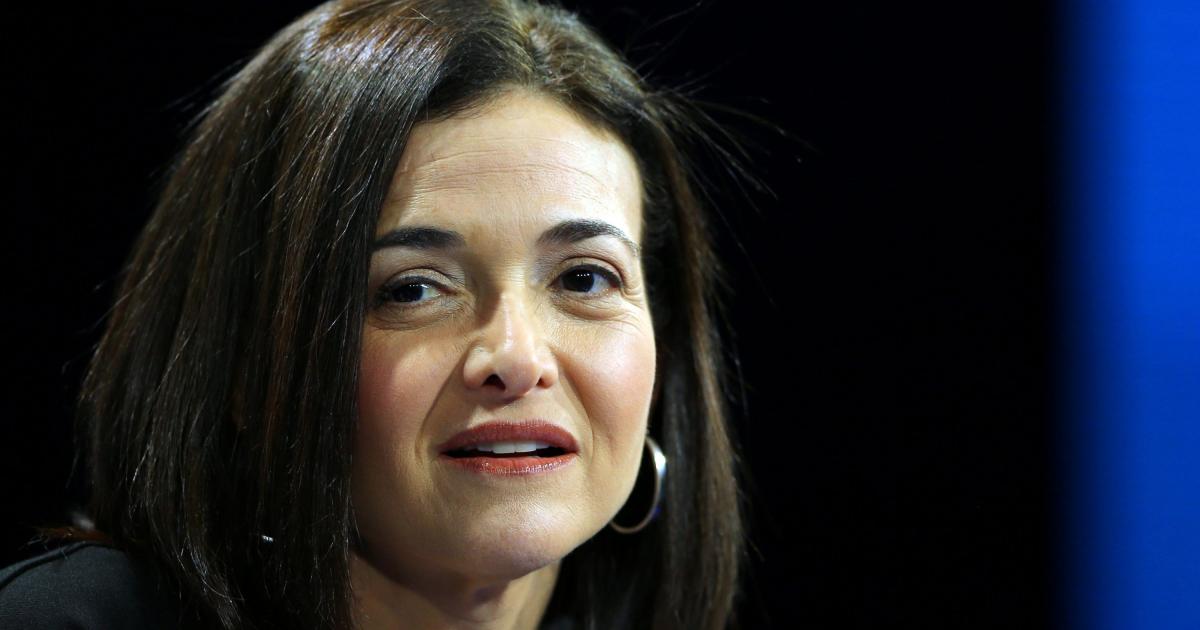What ever happened to Sheryl Sandberg? — Quartz at Work

When Adam Grant asks his students at Wharton to name a leader they admire, Sheryl Sandberg’s name always comes up. “There’s usually not even another woman mentioned,” says Grant, a professor and organizational psychologist who co-authored the book Option B with Sandberg in 2017.
That’s a testament to the alarming dearth of women running big companies these days—but also to Sandberg’s unique position in the public consciousness as the chief operating officer of Facebook and author of the 2013 corporate-feminist manifesto Lean In.
For more than a decade, Sandberg has been the most powerful woman in Silicon Valley, and perhaps in all of business. Lean In sold more than 4 million copies, launched a nonprofit of the same name, and inspired more than 50,000 women to join Lean In circles of their own to discuss the issues they face at work. At various points, her name has been tossed around as a possible US Treasury secretary pick, or even a potential US presidential candidate.
But for the past few years, as Facebook has been rocked by a string of scandals and crises, Sandberg’s reputation has taken a hit, and she’s been less frequently in the spotlight. It’s a noticeable shift from the early to mid-2010s, during which she was seemingly ubiquitous, cast in the media as a tough but sympathetic leader challenging Silicon Valley’s ingrained sexism and seeming lack of humanity.
Her new, lower profile speaks to the changing dynamics of Facebook’s leadership, and to her role in some of Facebook’s gravest missteps. It also speaks to some dark truths about what it can mean to be a powerful woman in business.
Where did Sheryl Sandberg go?
To be clear, Sandberg is hardly in hiding. In recent months, she’s spoken at conferences and in media interviews about topics like election disinformation, the US insurrection, and how the Covid-19 pandemic is impacting women in the workplace. She’s on Facebook’s earnings calls with Wall Street analysts, and she regularly hosts live panels and Q&As on Facebook and Instagram, interviewing everyone from Asian-American small business owners to infectious disease experts to scholar Michael Eric Dyson on his book Long Time Coming: Reckoning with Race in America.
REUTERS/Brendan McDermid
Her own social media feeds are filled with updates tied to Covid-19, her long-standing concern with women in the workplace, and her current cause of helping small businesses in the wake of the pandemic. These are interspersed with occasional images of Sandberg and her family: a photo of her with her fiancé, Tom Bernthal, and her parents celebrating Passover; Sandberg and Bernthal rock-climbing on their second anniversary; the pair at a food truck court in San Francisco, their first dining out excursion in more than a year.
But she has been a less prominent representative of Facebook in the aftermath of crises including the Cambridge Analytica scandal, the spread of disinformation in the 2016 US election, and the use of the platform to perpetuate genocide in Myanmar—and as a result seems to have lost prominence in the public’s consciousness.
Facebook’s balance of power
The notion that Sandberg’s star has fallen is tied to the fallout from Facebook’s various scandals. A 2018 article in the Wall Street Journal reported that Facebook CEO Mark Zuckerberg told Sandberg that “he blamed her and her teams for the public fallout over Cambridge Analytica,” prompting her to wonder aloud to friends “if she should be worried about her job.” In October 2020, the Journal reported further on the “shifting balance of power between the two executives, who were long regarded inside and outside the company as nearly equals,” writing that Sandberg had taken to saying, “I serve at the pleasure of Mark and the board.”
Others say Sandberg isn’t actively being sidelined. (Sandberg declined to be interviewed for this story.) Rather, they say, Facebook’s tumultuous past few years have forced Zuckerberg to take on more of the public-facing duties that used to fall in Sandberg’s territory, and to engage with policy and communications matters he’d previously steered away from.
The duo’s complementary partnership had long been rooted in a division of labor, with Sandberg handling management, advertising, and politics. Her strengths coincided with “the things I don’t want to do,” as Zuckerberg told the New Yorker way back in 2011.
But now that Facebook has repeatedly faced scrutiny from legislators over its handling of user data, its ambitions to delve into cryptocurrency, and whether it’s creating a social-media monopoly, Zuckerberg—historically focused on product at Facebook—reportedly doesn’t feel he has the luxury of steering away from other matters. “When you’re put in the hot seat in front of Congress three times now, my perception watching him is, he wants to have more insight into all the parts of his business that he might not have had a keen interest in in the past,” says reporter Mike Isaac, who covers Facebook for the New York Times. “So by default, that’s going to change the dynamic between Sheryl and Mark.”
REUTERS/Leah Millis
Debbie Frost worked with Sandberg at Google and at Facebook, where she served as vice president of global communications and public affairs before becoming an advisor to Sandberg’s foundation. She agrees that the public is seeing less of Sandberg these days because we’re seeing more of Zuckerberg. “Because of the calls for testimony, there was a lot more Mark,” she says. “He was out there on Capitol Hill for 20 hours; that’s the role of the CEO. My observation was that there wasn’t any real change in the work inside.”
Of course, even if the reasons Sandberg has been less in the spotlight are more about Zuckerberg than anything else, there can still be repercussions for her career. The New York Times in 2020 reported that “privately, Ms. Sandberg has worried that she was being pushed aside and that her role at Facebook has become less important” as Zuckerberg has stepped up.
Sandberg is sharpening Facebook’s focus on small business
In the wake of the pandemic, Facebook announced two $100 million grant programs for small businesses, one of which was specifically earmarked for Black-owned businesses and nonprofits and Black creators. It also introduced a slew of new features, including one that lets small businesses upload their catalogs so that people can shop directly from the site, and another called Business Suite, which is meant to help small businesses with their launches.
This spring, Sandberg has been meeting with small business leaders and local economic leaders in cities across the US, including Chicago, Salt Lake City, Tampa, Florida, and Detroit and Grand Rapids in Michigan, with plans to take the tour international in the fall.
The focus on small business is no doubt refreshing at a company that spent much of the past five years inundated with questions and controversy over its role in the US and global political arenas. The Jan. 6 insurrection at the US Capitol, however, was a reminder that Facebook is still very much grappling with the question of how to prevent people from using its platform to enact violence and spread conspiracies and disinformation. And that’s only one example of recent issues that have done damage to Facebook reputation, and by extension, Sandberg’s.
The question of Sandberg’s accountability
It’s not always clear, to outsiders, the extent to which Sandberg is culpable for Facebook’s problems. “No one really knows,” says Charles Elson, a professor of finance at the University of Delaware who specializes in issues regarding corporate governance.
The difficulty of answering the question is tied in part to Facebook’s dual-class stock structure, which gives Zuckerberg huge voting power. This effectively neuters Facebook’s board, Elson says, so that Zuckerberg is the only person with real power to evaluate Sandberg’s performance. “If he’s happy with her she stays, if he’s not happy with her, she doesn’t.”
What is clear is that, over the past few years, Sandberg has frequently faced criticism for her oversight of Facebook. She’s been accused of downplaying the company’s internal findings on Russian meddling in the 2016 election; admitted to commissioning research on George Soros in light of the financier’s criticisms of Facebook after initially dodging responsibility for hiring opposition research firm Definers Public Affairs; and come under fire for everything from her role in the Cambridge Analytica scandal (“I feel deeply personally responsible,” she told Bloomberg) to the site’s failure to review and remove content inciting genocide in Myanmar.
REUTERS/Jim Bourg
This year alone, Sandberg has faced censure on several fronts. ProPublica found that she had approved Facebook’s 2018 decision to cater to censorship demands from the authoritarian Turkish government, writing in an email, “I am fine with this.” And she’s received backlash for denying that the people behind this January’s attack on the Capitol used Facebook’s platform to coordinate, saying that it had been “largely organized on platforms that don’t have our abilities to stop hate, don’t have our standards and don’t have our transparency.” To the contrary, the Washington Post reported that researchers found that more than 128,000 people on Facebook were using the hashtag #StoptheSteal and associated hashtags to plan for the rally. And BuzzFeed got ahold of an internal report in which Facebook admitted that it had failed to sufficiently distinguish between individual people expressing themselves and organized movements plotting a coup.
Sandberg’s denial of Facebook’s role in the insurrection is indicative of the role she frequently takes when the company lands in hot water, says Angelo Carusone, president and CEO of the progressive nonprofit watchdog group Media Matters for America, which is focused on combating right-wing disinformation.
Sandberg “is perceived as having, for a variety of reasons, that if she’s making a statement, that it’s sincere and genuine and true,” says Carusone. “That strategic deployment of her certainly was no accident; they recognized she was the best person to make that proclamation.”
Sandberg’s beginnings
Sandberg’s usefulness in Silicon Valley was long apparent to Larry Summers, the former US Treasury secretary and mentor to Sandberg. He advised her on her senior thesis in economics at Harvard and appointed her as his research assistant at the World Bank after she graduated. “She was very smart and remarkably effective, and what she said she was going to do, she did more quickly and better than she said she was going to do it,” he recalls. Later, she became Summers’ chief of staff while he ran the Treasury under former US president Bill Clinton.
Summers says he always thought Sandberg had a future in the private sector—and in tech in particular.
“I told her that I thought her future was in, and I used this phrase, ‘civilizing geeks,’” Summers says. “I said, there are all these genius entrepreneurs in places like Silicon Valley who are really fantastic, but for whom their ultimate success is going to depend on something other than their ability to just program the computer.”
Summers says he told Sandberg that her talents were well-suited to helping the tech world navigate matters of business and policy: she had all the standard attributes of an excellent investment banker or McKinsey consultant, “plus you are smart enough, which most of those people aren’t, to earn the respect of [Silicon Valley types]. And you have the kind of human skill to navigate between the two worlds.”
A timeline of Sheryl Sandberg’s career
1991: Sandberg graduates with a bachelor’s degree in economics from Harvard University
1991-1993: Sandberg works for her mentor, Larry Summers, during his tenure as chief economist at the World Bank
1995: Sandberg graduates from Harvard Business School with her MBA
1995-1996: Sandberg goes to work for McKinsey & Company
1996-2001: Sandberg serves as Larry Summers’ chief of staff in his roles as deputy Treasury secretary and Treasury secretary under Bill Clinton
2001-2008: Sandberg joins Google, where she eventually becomes vice president of global sales and online operations
2008: Sandberg joins Facebook as COO
2010: Sandberg delivers her TED talk, “Why we have too few women leaders”
2013: Lean In is published and stays on the New York Times bestseller list for over a year
2017: Sandberg publishes Option B, her book with Adam Grant on coping with the loss of her husband
Summers’ predictions proved accurate: Sandberg made a name for herself, first at Google and then at Facebook, with what many regarded as a unique blend of straight-shooting business sense and emotionally intelligent leadership. And in some ways, Sandberg’s career at Facebook has been a marked success. Her mission in joining the company was to make it profitable, and she did so with flying colors by monetizing its advertising business.
“If we’re judging her reputation based on her business performance, [she gets] top marks,” says the Times’ Isaac. “Facebook has been reaping profits pretty much consistently every quarter since it was a public company … But I don’t think that’s the benchmark. There are broader considerations beyond just, Are you making this amazing business and is Wall Street happy?”
Confronting what Facebook has unleashed on humanity
Media Matters’ Carusone sees Sandberg as a powerful COO. Yet he says that in pivotal decisions concerning disinformation over the past few years, such as whether Trump was violating Facebook’s policies and the question of anti-conservative bias in Facebook’s algorithms, Sandberg “allows Kaplan [Joel Kaplan, Facebook’s head of global public policy] to be the principle decision-maker and policy-maker when it comes to some of these trajectory-setting actions.” His criticisms of Sandberg tend to come down to a lack of action, leading him to conclude that she’s “at best enabling, and at worst complicit.”
Yet Carusone says he’s not willing to entirely write her off. “I hold out hope for a proactive Sheryl Sandberg, even though there’s not evidence,” he says. “Maybe because that’s our best shot, just holding out hope that at a minimum she’ll grab the wheel before they tank our entire society.”
Broadly speaking, public sentiment about Facebook has taken a nosedive since the 2016 election, too. An April 2019 survey by NBC News and the Wall Street Journal found that 60% of Americans say they don’t trust Facebook “at all” with their personal information, compared to 28% distrusting Amazon and 37% distrusting Google. And a 2019 survey from Harris Poll of the 100 most visible US companies found that Facebook was considered the 94th-most reputable, plunging further from the un-boast-worthy ranking of 51 the year before.
REUTERS/Philippe Wojazer/File Photo
Even Sandberg’s friends don’t deny Facebook’s problems. Summers suggests, however, that there’s a certain inevitability to the fact that problems will arise with any new and massively popular technology.
“I’m not saying [Sandberg] would make the comparison, but there are all kinds of issues that arose for humanity after the wheel, and after fire, and [any] innovation of that significance,” says Summers. “But I think she thinks that the job is to kind of work through all those issues, figure out the best kinds of solutions, and move forward. That’s what she tries to do. And she recognizes that not everything’s going to work the first time or is going to work perfectly.”
With the benefit of hindsight, he says, anyone might make different decisions. “But I think she’s kind of determined to make decisions that are as wise as possible given the information that they have at their disposal.”
The question of sexism versus valid criticism
For high-profile executives at high-profile companies, criticism usually comes with the territory, as Radical Candor author Kim Scott, who worked for Sandberg at Google, observes. “When I was coaching Dick Costolo, when he was the CEO of Twitter, we used to joke that if you’re in the press a lot, you’re often on a hero-shithead rollercoaster,” Scott says. “And you’re never the hero they say you are, and you’re never the shithead they say you are either.”
But she suspects Sandberg may be facing a different kind of backlash than a man in her position might have. “One of the things that has bothered me about the coverage of Sheryl is the extent to which it reflects and reinforces gender bias,” says Scott.
Scott says there’s entrenched sexism that shows up in articles suggesting Sandberg’s management style is overly harsh, or that the heights of her career are behind her. Sandberg is, after all, still the COO of a company with roughly 2.9 billion monthly active users, equivalent to one-third of the global population. “Find me the 50-year-old male CEO of a major company”—or COO, as may be the case—”that he really helped to build and people asking if his career is waning,” Scott says.
Rachel Thomas, the co-founder and CEO of LeanIn.Org, makes a similar point when I ask her about Sandberg’s legacy. “Legacy is a funny question,” she says. “She’s 52, so it’s a little early to talk about her legacy as a leader, because she’s still very much on her own journey.”
It’s not just Sandberg’s allies who are concerned about how sexism shapes the public conversation about her. Eleanor Beaton is a women’s leadership development coach and the author of the forthcoming book Explicit Ambition: Why Women Don’t Want Power, and What We Want Instead. She notes that in depictions of women leaders from classical antiquity onward, “normally women who have a voice and challenge authority or the status quo are often depicted being silenced in gruesome ways, having their tongues ripped out.” She sees a connection between such imagery and the ways in which Sandberg has been less in the spotlight in recent years. “The most common way in which a woman is disempowered is to be silenced.”
The backlash against Lean In
Of course it’s difficult to assess Sandberg’s impact without also addressing Lean In, a book with its own complicated legacy. When it was published in 2013, the topic of persistent gender inequalities was still “taboo in the corporate world,” Grant says. “She was willing to point out a lot of barriers to women’s success at work that, frankly, were not going to be welcome messages for rooms of men to hear.”
Sandberg told The Guardian that when she gave a TED talk in 2010 that laid the groundwork for Lean In, her male colleagues warned her that doing so “would be the official end of my career. Once I gave a talk on women, I would be a ‘woman executive’. You can’t possibly care about women’s issues and be a serious business person.” Her decision to go ahead with the talk, and later Lean In, opened up a massive public dialogue about the issues professional women faced at work and what might be done about them.
Key quotes from Lean In
“Women need to shift from thinking ‘I’m not ready to do that’ to thinking ‘I want to do that—and I’ll learn by doing it.’”
“I truly believe that the single most important career decision that a woman makes is whether she will have a life partner and who that partner is. I don’t know of one woman in a leadership position whose life partner is not fully—and I mean fully—supportive of her career.”
“There is no perfect fit when you’re looking for the next big thing to do. You have to take opportunities and make an opportunity fit for you, rather than the other way around.”
But Lean In quickly drew criticism for neglecting to adequately consider the experiences of single moms (Sandberg’s advice was predicated on the importance of choosing a supportive partner) and women of color, and critics said the book failed to adequately grapple with the systemic issues that were holding women back at work. “The advice in there was teaching women tips and tricks to thrive inside a system that was broken and would never support them in the first place,” says Beaton.
Michelle Obama criticized the book in 2018 while promoting her own book Becoming, saying, “I tell women, that whole, ‘You can have it all’ — mmm, nope, not at the same time, that’s a lie. And it’s not always enough to lean in, because that shit doesn’t work all the time.”
Sandberg herself has acknowledged some of the book’s shortcomings. In 2016, Sandberg posted on Facebook about how the death of her husband, Dave Goldberg, had given her insight into the difficulties of single parenthood that she’d previously overlooked, while acknowledging that she also had enormous financial privilege that many single mothers lack. She addressed the issue in Option B as well, writing:
When I wrote Lean In, some people argued that I did not spend enough time writing about the difficulties women face when they don’t have a partner. They were right. I didn’t get it. I didn’t get how hard it is to succeed at work when you are overwhelmed at home. I wrote a chapter titled “Make Your Partner a Real Partner” about the importance of splitting child care and housework 50/50. Now I see how insensitive and unhelpful this was to so many single moms who live with 100/0.
“I do not know that many authors who take their mega-successful book and then write very openly, Here’s what I was wrong about,” Grant says.
As for the idea that Lean In was too focused on individual women’s success as opposed to systemic reform, a look back at the book shows that Sandberg was aware of that issue even at the time. “I understand the paradox of advising women to change the world by adhering to biased rules and expectations,” she writes in a chapter about negotiating, discussing the ways in which women are damned if they do and damned if they don’t. “I know it is not a perfect answer but a means to a desirable end.”
“She didn’t want it to be about her”
It may be that some of that of the backlash to Lean In is less about its message than its messenger. Grant says Sandberg never wanted the book to be focused on her. Grant recalls her late husband telling him that when he read the first draft of the book, it was all data, with none of her personal experience. Dave Goldberg advised his wife to start over, telling her, as Grant remembers it, “You have to be willing to share stories, that’s what’s going to move them,” in Grant’s recollection.
Grant says Sandberg’s late husband also told him that “Sheryl didn’t want to have her face on the cover; she didn’t want it to be about her.” (She apparently lost that battle.) Grant’s point seems to be that despite Sandberg’s reservations, the book ultimately became somewhat conflated with her privileged position. “Because her story is the anchor for the book, it overshadowed the way it got interpreted,” he says. “The data is much more representative of the population.”
“Lean In” as a relic of the pre-MeToo era
Sandberg has owned up to her blind spots. But these days it seems that Lean In is an artifact of its time—a book that many women found useful, but has less relevance as the contemporary conversation evolves to imagine a more inclusive and radical feminist overhauling of the modern workplace.
Molly Roberts wrote in the Washington Post that Sandberg’s post-2016 years exemplify the problems with the idea that companies necessarily get better when women win a seat at the table. “But what should they do once they’re sitting there?” Roberts wrote. “Sandberg herself, consummate table-sitter, has offered an answer over her company’s year of horrors: Keep everything exactly the same.”
The organization Lean In, meanwhile, has emphasized that it’s distinct from Sandberg.
“I don’t want to take anything away—how could I?—from Sheryl as the inspiration for the work that we do,” CEO Rachel Thomas told the Times in 2018. “But the book came out six years ago. It’s become less and less about Sheryl with every passing year.”
Thomas tells Quartz that when Lean In first launched, its initial focus was on community-building, and facilitating discussion groups under the principle that “women coming together to support each other could go further.” The organization’s major points of evolution in the ensuing years have been in focusing on intersectionality and pushing for systemic change, precisely the points that the book has most frequently taken hits for.
“We really started to focus on collecting data to understand the experiences of women of color; over time we’ve added looking deeply at looking at the experiences of lesbian women and bisexual women, women with disabilities—we’re always looking to open the aperture, both in our research and in other areas of our work,” Thomas says. She points to the organization’s latest version of its training program on ways to fight bias in the workplace. “In the second version of it, it’s gone from 50 ways to fight bias to almost 100 ways to fight bias, because we’ve been increasingly building out the intersectional piece of it,” she says. “About half of the situations and solutions now are explicitly intersectional.”
There are some clear positive cultural impacts that Sandberg has had on the modern workplace. She successfully challenged companies to improve their bereavement leave policies after experiencing their importance firsthand after the death of her husband, prompting change at companies like Bank of America, AirBnB, and Mastercard. Her championing of men taking paid parental leave has helped shift the status quo in tech in particular, according to Scott. And just this year, at Sandberg’s behest, Facebook established a new policy to provide up to 20 days of paid leave to any employee who is a victim of domestic violence, or related to someone who is.
Perhaps most crucially, Sandberg helped normalize talking about gender in the workplace at all. “As Kimberlé Crenshaw said, we can’t fix what we won’t name, and she helped us name a lot of things,” Scott says.
Could politics still be in Sandberg’s future?
Many people expected Sandberg to join Hillary Clinton’s cabinet after the 2016 election, which—as we all know well—didn’t go as planned. Politics could still be in Sandberg’s future down the line, but the controversies now surrounding big tech in general, and Facebook in particular, have perhaps changed those odds.
Beaton agrees that politics is a less likely path for Sandberg these days. “Her reputation was tarnished. I think for a woman in particular, it’s hard to come back from something like that.”
Grant, for his part, says this may not be much of a disappointment for Sandberg. “Why would anyone want to work in politics ever?” he says.
Is Facebook too big to fix?
Confidantes to Sandberg say she remains extremely committed to Facebook—not just despite Facebook’s many crises, but because of them.
“There’s no tech that’s an unmitigated good,” says Grant. “One of her major goals is to try to eliminate as much harm as possible and maximize the good the platform can do,” and to “prevent bad actors from misusing it.”
“She’s in a position to solve a lot of problems,” Grant adds, “not just social media problems but problems that are affecting the world.” In other words, Sandberg is drawn to Facebook because the company operates at the intersection of weighty issues concerning democracy, freedom of speech, and disinformation—even if critics often accuse the company of landing on the wrong side of them.
Frost agrees regarding Sandberg’s motivations. At Facebook, she says, “the problems are hard, but there aren’t a lot of problems like them because of the impact the product has on so many people. If you want to be a good steward of the company, you don’t leave.”
Can Sandberg still be seen as a force for good?
REUTERS/Nyein Chan Naing/Pool
It’s easy to understand how Sandberg might see herself as a force for good at Facebook, pushing for what’s right from within, winning some battles and losing others, making some calls that turn out well and others that don’t. That describes a lot of people in a lot of jobs. What makes her position different is that the stakes at Facebook are so very high, and its power so vast, that the cost of bad calls and other missteps can have an almost immeasurable toll on society.
“I think it’s important to separate Facebook and Sheryl,” Scott says, “because although Sheryl certainly works at Facebook, they are two different entities.”
No doubt they are, but for those who believe that Facebook does more harm than good, it’s hard to reconcile the idea of Sandberg as a flawed but decent-minded public figure with the track record of the company where she’s number two. Nor is it at all clear how possible it is for any individual to get the problems of a gargantuan social-media empire with billions of users under control.
Personally, I think Facebook is probably too big to fix. Yet I can’t shake the instinct to root for Sandberg as an individual, for reasons that were illuminated during my conversation with Scott.
Scott described the “gender pattern-matching” that she experienced in her career after Sandberg, her former boss, became COO of Facebook. “I got so many calls from recruiters offering me COO jobs because I’ll be the Sheryl Sandberg of XYZ company,” she said, despite the fact that “I would be a terrible COO. I’m very disorganized, I would be much better in any number of roles.”
I thought about how, quite unconsciously, I’d been following the developments in Sandberg’s extremely high-profile career for the bulk of my own, absorbing frequently thorny lessons about how women can speak in a way that commands respect, what kinds of behaviors earn praise or condemnation, pondering the distinctions between deserved critiques and outright pile-ons.
Of course, there were plenty of women who didn’t see themselves in Sandberg, plenty of women who have faced challenges she never will. And yet. I floated a theory with Scott: “I imagine because Sandberg is one of the most powerful women in business, what happens to her has a big trickle effect—” I began.
Scott finished my thought. “On what happens to all of us.”





